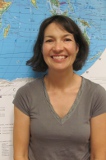Emma Blake

Tel: 520-626-4922
Fax: 520.621.2088
Office: Emil W. Haury Building, Room 227
Email: ecblake@email.arizona.edu
Emma Blake is an archaeologist who studies Italy in the second and first millennia BCE. Her doctoral dissertation focused on monumentality on Sardinia in the Bronze Age, but since then she has shifted her fieldwork to northwest Sicily, where she has worked for many years, first as an Assistant Director on the Monte Polizzo excavations, and since 2008 as Co-Director of the Marsala Hinterland Survey, an intensive field survey along the coast adjacent to the Phoenician colony of Motya. She is also at work on a book on social networks and emergent ethnicities in pre-Roman Italy.
Degrees
- Ph.D., University of Cambridge
- BSc. in Foreign Service, Georgetown University
Research Interests
Mediterranean Archaeology; Italy in the Bronze and Iron Ages, colonialism and diaspora, archaeological theory, cultural identity, megalithic monuments, ceramic analysis, social networks
Selected Publications
- 2010. The Marsala Hinterland Survey: Preliminary Report. Etruscan Studies 13: 49-66
- 2008. The Mycenaeans in Italy: a minimalist position. Papers of the British School at Rome 76: 1-34
- 2005a. E. Blake and A. B. Knapp, eds. The Archaeology of Mediterranean Prehistory. Oxford: Blackwell.
- 2005b. A.B. Knapp and E. Blake. Introduction: The Corrupting and Connecting Sea. In The Archaeology of Mediterranean Prehistory (E. Blake and A.B. Knapp, eds). Oxford: Blackwell, pp. 1-23.
- 2005c. The Material Expression of Cult, Ritual, and Feasting. In The Archaeology of Mediterranean Prehistory (E. Blake and A.B. Knapp, eds). Oxford: Blackwell, pp. 102-29.
- 2004. Space, Spatiality, and Archaeology. In The Blackwell Companion to Social Archaeology (L. Meskell and R. Preucel, eds). Oxford: Blackwell, pp. 230-54.
- 2003. The Familiar Honeycomb: Byzantine Era Reuse of Sicily's Rock-cut Tombs. In Archaeologies of Memory (R. VanDyke and S. Alcock, eds). Oxford: Blackwell, pp. 203-20.
- 2002a. Situating Sardinia's Giants' Tombs in their Spatial and Social Contexts. In The Space and Place of Death (H. Silverman and D. Small, eds). Arch. Papers of the Am. Anthropological Assoc. vol. 11, pp. 119-27.
- 2002b. Spatiality past and present: An interview with Edward Soja. J of Social Archaeology 2.2: 139-58.
- 2002c. I. Morris, T. Jackman, E. Blake, S. Tusa. Stanford University excavations on the Acropolis at Monte Polizzo, Sicily, II: preliminary report on the 2001 season. Memoirs of the American Academy in Rome 47: 153-98.
- 2001a. Locales as Artifacts: The Spatial Relationship Between Towers and Tombs in Nuragic Sardinia. American J of Archaeology 105: 145-61.
- 2001b. I. Morris, T. Jackman, E. Blake, S. Tusa. Stanford University excavations on the Acropolis at Monte Polizzo, Sicily, I: preliminary report on the 2000 season. Memoirs of the American Academy in Rome 46: 253-71.
- 1999a. Identity-mapping in the Sardinian Bronze Age. European J of Archaeology 2.1: 55-75.
- 1999b. Coming to terms with local approaches to Sardinia's nuraghi. In Archaeology and Folklore (A. Gazin-Schwartz and C. Holtorf, eds). London & NY: Routledge, pp 230-99.
- 1998. Sardinia's nuraghi: four millennia of becoming. World Archaeology 30.1: 59-71.
- 1997a. Strategic symbolism: miniature nuraghi of Sardinia. J of Mediterranean Archaeology 10.2: 151-64.
- 1997b. Negotiating nuraghi: settlement and the construction of ethnicity in Roman Sardinia. In Theoretical Roman Archaeology Conference 1996 Proceedings (K. Meadows, C. Lemke, J. Heron, eds). Oxford: Oxbow, pp. 113-9.
Projects
The Marsala Hinterland Survey, an intensive archaeological field survey in northwest Sicily. 2008-ongoing. Co-Director with Robert Schon.